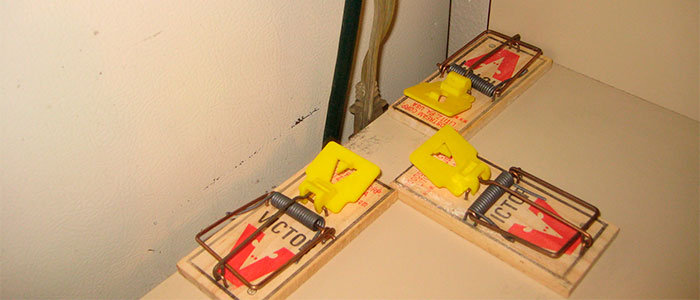
- LAST UPDATED: December 12, 2023
Mice can be extremely irritating in your home, and if you’ve got more than one or two, you have a real pest problem on your hands. The last thing you want is mice around your kids and family, but getting rid of them is not always easy.
In many cases, it’s not that traps don’t work. Instead, it’s likely a user error or simply the wrong kind of trap. Keep reading to learn more about how to deal with mice that won’t take the bait and spring your traps. Once you figure out the solution, you can reclaim your home from those pesky rodents.
Contents
Reasons Your Mouse Traps are Not Working
Setting a mouse trap, at least once you get the hang of it, is a relatively easy thing to do. That’s why it can be so surprising when a mouse trap that you’ve placed in your home simply doesn’t work. There are a few reasons this can happen, even if you’ve got the best mouse traps on the market.
If you’ve got mice in your home, and you want to get rid of them for good, figuring out why the mice aren’t taking the bait and springing your traps is a must.
Why Do Mice Keep Eating Bait Off Traps?
Bait designed to lure mice is essential when you want to get rid of pests around your home. In some cases though, mice can eat the bait without setting of the traps, leaving you scratching your head.
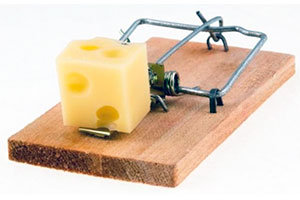
- You are using the wrong type of bait. Items like small pieces of cheese may be enticing to mice and rats because of their smell, but they aren’t always the best for setting of traps.
- Mice are able to pull large pieces of food like bits of cheese off traps without stepping on them. This means that the kill bar on a standard trap is not able to close in time to catch the mice.
- You’re not setting the traps properly. Setting a mouse trap is often a little confusing for first time users. If you’re not setting the traps right or with enough sensitivity, mice may be able to remove the food without being caught in the process.
Using the Right Bait
There are a variety of different readymade types of bait on the market. Many reputable brands including products like the Tomcat mouse trap make setting your trap a little bit easier. If you’re not using pre-baited traps though, you may be making the wrong choice when it comes to luring mice.
- Avoid using large, heavy pieces of food like cheese or meats. Mice may be lured to these scents in some cases, but they aren’t always effective. Heavy, solid foods are also easier for mice to remove without being caught in a trap.
- Use peanut butter or hazelnut spread to lure mice to traps. Mice can’t pick up peanut butter or hazelnut spread and run away, instead having to eat it at the source – the trap. If a mouse has to stay near the trap to get the peanut butter or hazelnut spread they’ll be a lot more likely to get caught.
- Replenish your bait at least once per week. Mice are attracted to the scent of bait they want to eat, but if the bait is old, they likely won’t find the traps very quickly. They may also not be interested in the bait once they do find it if it’s too old.
Are You Using the Wrong Type of Trap?
There are a variety of different mouse traps out there and most of them are effective if used the right way. In some cases though, you may be using the wrong type of trap, at least for the mice in your home.
Add a bucket mouse trap to your arsenal. Bucket mouse traps can be purchased online or you can make your own if you’re handy. Bucket traps are designed to lure mice onto a spinning platform that makes them fall into a bucket. From there, the mice can be taken away from your home so they don’t come back.
Try using standard spring action kill traps in your home if bucket traps don’t work. These are cost-effective, but not always helpful if you only have one or two mice around your home or property.
Look for traps where mice are trapped in a small area within your home so they can be removed. Sometimes mice that avoid bucket or kill traps can be enticed into a trap that will capture them without harming them.
Do Mice Know How to Avoid Traps?
Whether or not mice know how to avoid traps is something of a point of contention in many circles. While mice can be taught things in laboratories and they are intelligent small creatures, there’s little evidence to prove that mice in the wild learn about traps and how to avoid them.
Instead, it’s a lot more likely that mice who aren’t taking the bait or getting stuck in traps are not interested in the food, or they are accessing it without stepping on the pedal of a kill trap.
How to Catch a Mouse That Avoids Traps
Mice are rather intelligent creatures, and trapping them doesn’t always prove easy. If you’re like some people, you probably feel like you’ve got very smart mice in your home if you’ve been using traps without success for some time.
Follow these steps to catch a mouse that avoids traps:
- Position traps properly around your house. Along the walls is your best bet for catching mice since they tend to stay close to walls. Mice rarely run through the middle of a room or look for food sources there.
- Use more traps around your home. Mice may simply not be in the area where you put the trap. Mice can move, and in many cases, they may not come back to the area where you saw them first for some time.
- Use traps outside your home and around points of entry. Trapping mice as they try to leave your home or come back into your home is key.
Mistakes and Solutions
Using the right type of traps and bait is a must if you want to catch mice in your home. While some mice can be tricky and avoid traps for a little while, doing everything you can to lure and trap them is important for you if you’re the one setting the traps.
Practice setting up your mouse traps and making sure they go off before putting them in place to actually catch mice. Keeping your fingers clear, simply drop something small like coin on the pedal of the trap. It should spring into action once the coin hits the pedal.
Avoid these common mistakes when setting and placing traps around your home:
- Don’t touch bait before you put it on or in a trap. Bait that smells like your hands won’t be nearly as enticing to mice. In some cases, your scent may scare them off completely. Always wear gloves when handling mouse traps and bait for traps around your home.
- You’re using the wrong bait. Use peanut butter or hazelnut spread. You can also choose pre-baited traps to make the process easier if they’re available in your area. Pre-baited traps can also be purchased online.
- You’re using too much of the right kind of bait. Using only a small amount will require a mouse to get closer to the trap, making them much more effective.
- You aren’t replacing the bait often enough. Bait should be replaced weekly so it has a scent that’s strong and tempting for mice.
- Your traps are not in the right place. The most effective spots for mouse traps are along the walls, near kitchen and bathroom cupboards and points of possible entry around doors and windows.
- You’re not using enough traps at once. Look to add at least one trap to parts of your home where you’ve seen mice. This is especially important if you feel you may have more than one in your home.
Having mice in your home, especially for a long period of time, is just plain gross. It’s not something any homeowner wants, but getting them out can feel like a challenge. Using the right types of traps the right way can make a big difference.
If you can’t get the mice out of your home in the first few weeks of using traps it may be time to call in the professionals. You may not want to hire somebody, but when you’re dealing with an infestation, time is truly of the essence. Professionals can also help you learn more about how to handle mice in the future and set up your traps the right way.


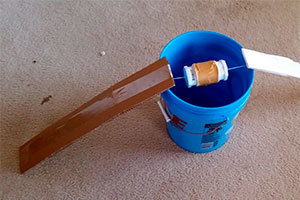
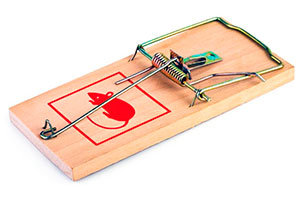 Try using standard spring action kill traps in your home if bucket traps don’t work. These are cost-effective, but not always helpful if you only have one or two mice around your home or property.
Try using standard spring action kill traps in your home if bucket traps don’t work. These are cost-effective, but not always helpful if you only have one or two mice around your home or property.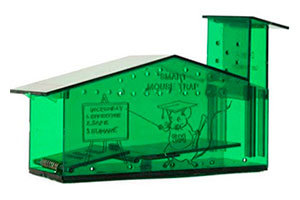 Look for traps where mice are trapped in a small area within your home so they can be removed. Sometimes mice that avoid bucket or kill traps can be enticed into a trap that will capture them without harming them.
Look for traps where mice are trapped in a small area within your home so they can be removed. Sometimes mice that avoid bucket or kill traps can be enticed into a trap that will capture them without harming them.